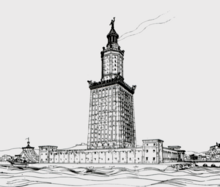 Drawing by archaeologist Hermann Thiersch (1909) | |
 | |
| Location | Pharos, Alexandria, Egypt |
|---|---|
| Coordinates | 31°12′53″N 29°53′10″E / 31.2148°N 29.886°E |
| Tower | |
| Constructed | between 284 and 246 BC |
| Foundation | Stone |
| Construction | Masonry |
| Height | 103 to 118 m (338 to 387 ft)[1] |
| Shape | Square (below), octagonal (middle) and cylindrical (top) |
| Light | |
| Deactivated | 1303 or 1323 |
| Range | 47 km (29 mi) |
The Lighthouse of Alexandria, sometimes called the Pharos of Alexandria (/ˈfɛərɒs/ FAIR-oss; Ancient Greek: ὁ Φάρος τῆς Ἀλεξανδρείας, romanized: ho Pháros tês Alexandreías, contemporary Koine Greek pronunciation: [ho pʰáros tɛ̂ːs aleksandrěːaːs]; Arabic: فنار الإسكندرية), was a lighthouse built by the Ptolemaic Kingdom of Ancient Egypt, during the reign of Ptolemy II Philadelphus (280–247 BC).[2] It has been estimated to have been at least 100 metres (330 ft) in overall height.[3] One of the Seven Wonders of the Ancient World, for many centuries it was one of the tallest man-made structures in the world.
The lighthouse was severely damaged by three earthquakes between 956 and 1323 AD and became an abandoned ruin. It was the third-longest surviving ancient wonder, after the Mausoleum at Halicarnassus and the extant Great Pyramid of Giza, surviving in part until 1480, when the last of its remnant stones were used to build the Citadel of Qaitbay on the site.
In 1994, a team of French archaeologists dived into the water of Alexandria's Eastern Harbour and discovered some remains of the lighthouse on the sea floor.[4] In 2016, the Ministry of State of Antiquities in Egypt had plans to turn submerged ruins of ancient Alexandria, including those of the Pharos, into an underwater museum.[5]
- ^ McKenzie, Judith (2011). The Architecture of Alexandria and Egypt: 300 BC – AD 700. Yale University Press. p. 42. ISBN 978-0300170948.
- ^ Clayton, Peter A. (2013). "Chapter 7: The Pharos at Alexandria". In Peter A. Clayton; Martin J. Price (eds.). The Seven Wonders of the Ancient World. London: Routledge. p. 11. ISBN 9781135629281.
- ^ Clayton, Peter A. (2013). "Chapter 7: The Pharos at Alexandria". In Peter A. Clayton; Martin J. Price (eds.). The Seven Wonders of the Ancient World. London: Routledge. p. 147. ISBN 9781135629281.
- ^ "Treasures of the Sunken City". Nova. Season 24. Episode 14. November 18, 1997. PBS. Transcript. Retrieved March 5, 2012.
- ^ "Sunken Ruins of Alexandria Will Be World's First Underwater Museum". Earthables. Archived from the original on March 10, 2016. Retrieved March 27, 2016.